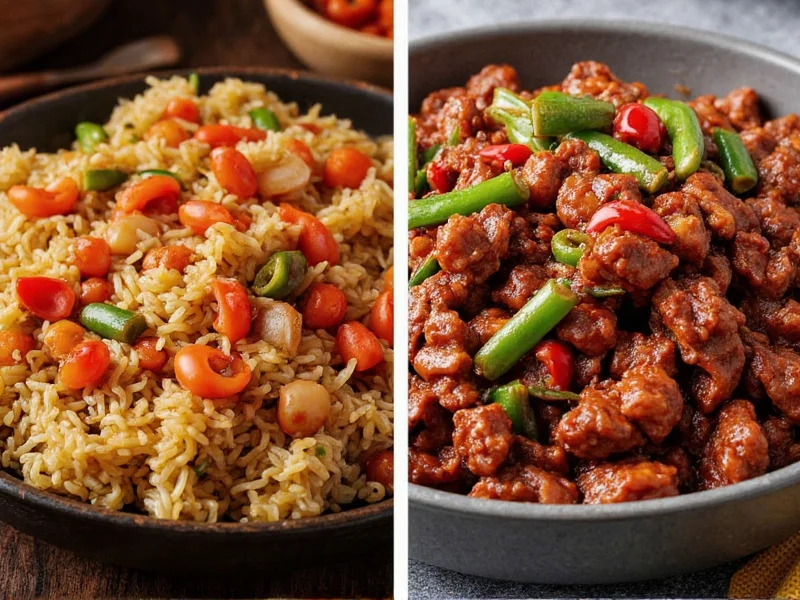Understanding the difference between Hunan style vs Szechuan style is essential for appreciating China's diverse regional cuisines. Both represent fiery culinary traditions from southern China, but their approaches to heat and flavor create distinctly different dining experiences that often get confused by Western diners.
Origins and Cultural Background
Hunan cuisine, also known as Xiang cuisine, originates from China's Hunan province, characterized by its humid subtropical climate. The region's abundant rainfall and humidity led locals to develop cooking techniques that incorporated generous amounts of fresh chili peppers to combat dampness. Sichuan cuisine, or Chuan cuisine, comes from Sichuan province in southwestern China, where the similarly humid climate inspired the development of the signature 'ma la' (numbing-spicy) flavor profile using Sichuan peppercorns alongside chilies.
Flavor Profile Comparison
The most fundamental difference between Hunan style vs Szechuan style lies in their approach to heat and flavor complexity:
| Characteristic | Hunan Style | Szechuan Style |
|---|---|---|
| Primary Heat Source | Fresh red chilies | Dried chilies + Sichuan peppercorns |
| Heat Quality | Direct, immediate burn | Numbing-spicy 'ma la' sensation |
| Flavor Complexity | Simpler, more straightforward | Layered with fermented ingredients |
| Oil Content | Higher oil content | Moderate oil content |
| Additional Flavors | Vinegar, garlic, shallots | Fermented beans, doubanjiang, complex spice blends |
Key Ingredients That Define Each Style
Hunan cooking relies heavily on fresh ingredients, particularly:
- Fresh red chilies (often whole or chopped)
- Vinegar for balancing heat
- Garlic and shallots
- Smoked meats and preserved vegetables
- Local river fish and poultry
Szechuan cuisine features more complex ingredient combinations:
- Sichuan peppercorns (huājiāo) for the numbing sensation
- Doubanjiang (fermented broad bean paste)
- Dried red chilies
- Various fermented black beans
- Complex spice blends including star anise and cinnamon
Cooking Techniques Compared
Hunan chefs typically employ stir-frying, steaming, and smoking techniques that preserve the natural flavors of ingredients while adding significant heat. The cooking process tends to be faster with less manipulation of the core ingredients.
Szechuan cooking involves more complex preparation methods including:
- Dry-frying (to release essential oils from spices)
- Velveting meats before stir-frying
- Multiple-stage cooking processes
- Specialized oil infusions with spices
These techniques create the signature layered flavors that distinguish authentic Szechuan dishes from their Hunan counterparts.
Signature Dishes to Try
When exploring Hunan style vs Szechuan style, certain dishes exemplify each tradition:
Hunan Specialties
- Steamed Fish Head with Chopped Red Peppers - A classic Hunan dish featuring fresh fish head topped with copious amounts of fresh red chilies
- Hunan Chicken - Features chicken stir-fried with fresh chilies, garlic, and vinegar for a direct spicy experience
- Dry Pot Frog - Tender frog legs cooked with fresh chilies and aromatics in a dry preparation
Szechuan Specialties
- Kung Pao Chicken - The famous dish with chicken, peanuts, dried chilies, and Sichuan peppercorns creating the ma la effect
- Mapo Tofu - Silky tofu in a spicy, numbing sauce with minced pork and fermented bean paste
- Dry-Fried Green Beans - Blanched then dry-fried with doubanjiang and Sichuan peppercorns
Which Is Actually Hotter: Hunan Style vs Szechuan Style?
Many diners wonder which regional cuisine delivers more heat. While both are spicy, Hunan cooking generally registers higher on the Scoville scale due to its liberal use of fresh red chilies. Hunan chefs prioritize direct, immediate heat that builds steadily. Szechuan heat works differently—the combination of chilies and Sichuan peppercorns creates a complex sensation where the numbing effect can actually moderate the perceived heat level, making it feel less intense despite containing significant capsaicin.
Common Misconceptions About Hunan and Szechuan Cuisine
Several myths persist about these regional Chinese cuisines:
- Myth: Szechuan and Hunan are interchangeable terms
Reality: They represent distinct culinary traditions from different provinces with unique flavor profiles - Myth: American Chinese 'Szechuan chicken' represents authentic Szechuan cooking
Reality: Most Westernized versions omit Sichuan peppercorns and use sugar-heavy sauces not found in authentic preparations - Myth: Hunan cuisine is just 'spicier Szechuan'
Reality: Hunan has its own distinct flavor philosophy focused on fresh chili heat rather than the complex ma la profile
How to Choose Between Hunan and Szechuan When Dining
When deciding between Hunan style vs Szechuan style at a Chinese restaurant, consider your heat tolerance and flavor preferences:
- Choose Hunan if you prefer straightforward, intense heat from fresh chilies
- Select Szechuan if you enjoy complex flavor layers with the distinctive numbing-spicy sensation
- For first-time diners, Szechuan might offer a more approachable introduction with its balanced flavors
- If you want maximum heat without numbing effects, Hunan cuisine typically delivers more direct spiciness
Authenticity Considerations in Western Restaurants
When exploring Hunan style vs Szechuan style outside China, be aware that many Western Chinese restaurants significantly adapt these cuisines. Authentic Szechuan restaurants will prominently feature Sichuan peppercorns in their spice blends, while genuine Hunan establishments will use generous amounts of fresh red chilies rather than relying primarily on dried varieties. The most reliable indicators of authenticity include Chinese-language menus, predominantly Chinese clientele, and chefs with regional culinary training.











 浙公网安备
33010002000092号
浙公网安备
33010002000092号 浙B2-20120091-4
浙B2-20120091-4